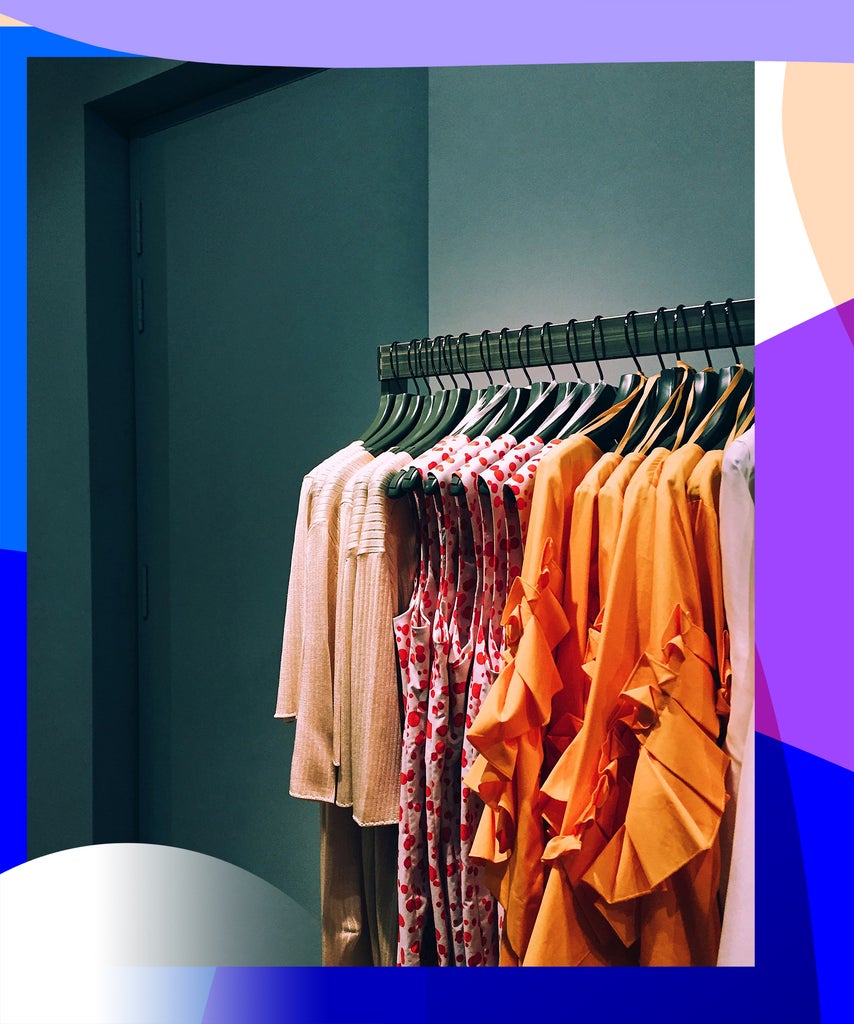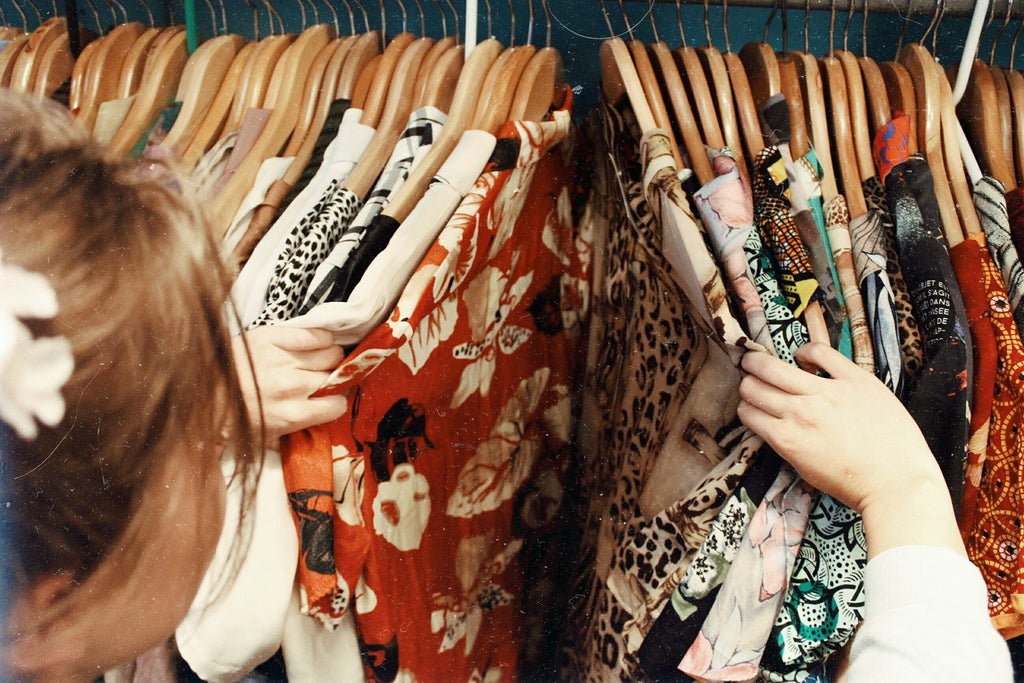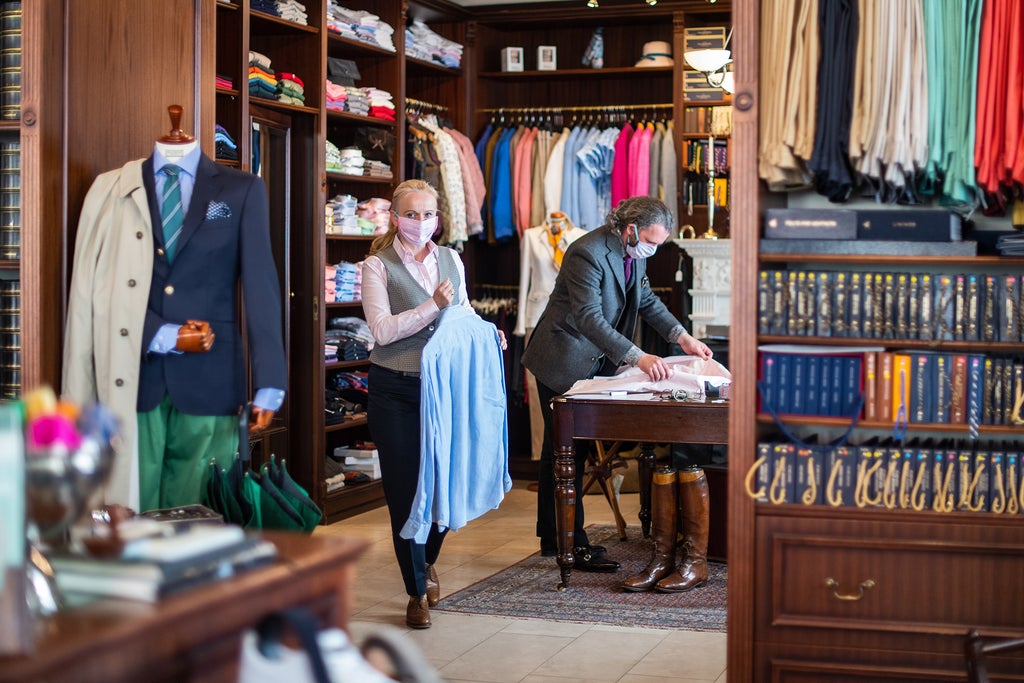What Is The Future Of Fast Fashion? It’s Complicated

Jenna Diioro is someone who lives to shop.
A 28-year-old car-dealership manager who lives in New Jersey, Diioro used to spend hours cruising stores like Abercrombie & Fitch, Forever 21, H&M, and Hollister, where she’d spend upward of $200 USD each week, scooping up tops, dresses, jeans, and activewear. Just last month, she was preparing to shell out for a new wardrobe for an upcoming trip to Cancun with her boyfriend.
All that changed once the coronavirus pandemic upended nearly every aspect of Diioro’s daily life. Since New Jersey governor Phil Murphy issued shelter-in-place orders on March 21, Diioro has hunkered down at home with her seven-year-old son. She browses clothing online more than she used to — mostly out of boredom — but aside from some yoga leggings, she hasn’t purchased much. And while a vacation in Cancun now feels like a distant dream, part of her still clings to the idea of eventually making it there. Diioro’s added the same tie-front romper to her cart multiple times, coming close, but never quite pulling the trigger.
“Should I buy it? Should I not? Am I going to be even able to wear it anytime soon?” Diioro says. “My girlfriends have been saying the same thing. When are we even going to be able to wear these cute clothes out and about?”
COVID-19 has dealt a bruising blow to fashion retail. Confirmed cases of the disease have surged past 1.9 million globally, with more than 123,000 recorded deaths, according to the World Health Organization’s April 15 situation report. Shuttered storefronts, evaporated foot traffic, and a sharp decline in consumer confidence have caused sales to nosedive. Inditex, the parent company of Zara, flagged a 24. 1 percent decrease in sales in the first two weeks of March; H&M says it saw a 46 percent drop the same month. Panicked retailers such as C&A, Gap, Primark, and Topshop have scrambled to cancel purchase orders from their overseas suppliers, or refused to pay for product, in order to get ahead of their collapsing bottom lines.
Even before the pandemic, fast fashion was undergoing major upheaval. News of Forever 21’s bankruptcy filing and H&M and Zara’s slumping revenues seemed to sound the death knell for the inexpensive, trend-driven retailers that populate malls around the globe — some of which are said to employ an overworked and underpaid workforce.
But this wasn’t a sign of a social and environmental “tipping point” for consumers — far from it. In truth, the old guard of fast fashion had ceded ground to nimbler pure-play upstarts like Boohoo, Fashion Nova, and Missguided, which, unyoked by decades of debt, expensive real estate, and clunky supply chains, had conspired to make fast fashion cheaper and more shoppable through newfangled channels like Instagram.
“They’ve cannily heavily capitalized on this new wave of consumer appetites, which are driven by a number of things, whether it’s social media or reality TV shows,” says Elizabeth Paton, a fashion reporter for the New York Times. “And I do think we need to put a lot more scrutiny on the business practices of these new-guard players because they’re very, very reluctant to release that information.”
Gen Z and younger millennials, goaded on by the influencers they follow, are driving this faster-fashion boom despite a reputation for being socially, politically, and environmentally “woker” than their forebears.
“For every Greta Thunberg and school-skipping climate change protester, there are hundreds of thousands if not millions of kids around the world, for whom their digital persona is an extension of themselves, how they’re perceived on social media is as important to them as how they’re seen in real life,” Paton says. “And they want as many different outfits as they can have, for as many posts as they do.”

What’s more, even the Greta Thunbergs of the world are limited by their incomes.
“They’re really making, as much as they can, smart choices when it comes to things that feel like the right thing to do for the environment or the right thing to do considering climate change,” Melanie Shreffler, senior director of insights at Cassandra, a youth-focused business-intelligence firm, tells me. “But they also have to reconcile that with the fact they just don’t have a ton of money to spend on certain things.”
Much of this conversation is moot now. With rattled consumers shifting their expenditures from shoes and clothing to groceries and cleaning supplies, fashion retail as a whole is in a freefall. The bigger question for fast fashion is whether the model, which hinges on its prodigious volume to make the razor-thin margins work, will survive the pandemic.
“One of the issues with fast fashion is a lot of it is impulse- and occasion-driven. Impulse-purchasing drops massively when consumers can’t visit stores,” says Neil Saunders, managing director of GlobalData Retail. “And as people are going to fewer events and having fewer nights out, occasion-driven purchasing drops back, too.”
Saunders predicts the economic fallout from the pandemic will be worse than 9/11 and the 2008 recession. Already, more than a fifth of the UK’s fashion expenditure — $13.5 billion USD — is poised to go up in smoke. In the United States, clothing and footwear sales could plummet by $19.4 billion USD, he says.
“The other issue for fast fashion is it’s highly seasonal,” Saunders adds. “While there will be some latent demand when things open back up, many of the lost purchases during this period won’t be repeated.”
E-commerce has been touted as the bright spot in this bleak landscape, but while some apparel spending is moving online as people batten down for comfort — globally, searches for sweatpants, hoodies, leggings, and Ugg slippers have ballooned, according to fashion search platform Lyst — it hasn’t given companies the bounce they’re craving. (Not to mention, stores like Next and Net-a-Porter have temporarily halted e-commerce over concerns for employee safety.) Online sales for fashion goods, according to McKinsey & Co, have fallen 5 percent to 20 percent across Europe, and 30 percent to 40 percent in the United States.
The hottest commodities right now aren’t Fenty slides or Off-White denim jackets, but toilet paper and Clorox wipes.
Roughly two-thirds of consumers have pulled back spending as the pandemic deepens, according to a Coresight Research study based on data from the week of April 8. (The number is up from the half who said as much the previous week.)
Gen Z, which contributes some $830 billion USD to US retail sales each year, is also tightening purse strings. When Piper Sandler polled 5,200 teens in 41 states in the U.S. between Feb. 17 and March 24 — the latter weeks of which saw schools switch to e-learning to help combat the spread of infection — it found that their overall spending fell by 13 percent compared with last spring and 4 percent from fall to $2,300 USD, resulting in the lowest level since autumn of 2011.
Julia Ziegler, an otherwise fashion-obsessed college freshman who is riding out the pandemic in Portland, Ore., tells me she’s dropping her money on room decor, books, and sweatshirts. Even the siren call of clothing sales, which have ramped up in recent weeks as companies struggle to offload aging stock, hasn’t swayed her.
“I’m not really inclined to buy anything for the future,” she says. “I’m 19; I don’t have a job right now, and there’s a lot of talk about the lockdown being extended.”
Achim Berg, senior partner at McKinsey & Co., and leader of its global apparel, fashion and luxury group, predicts that fast-fashion retailers, because of the vast quantities they traffic in, will have trouble purging existing inventory when stores reopen. In North America alone, 75 percent of apparel and fashion companies could face severe financial straits managing their debt, he says.
“Which means it’s going to be unusually competitive, because everybody will use markdowns and promotions in order to get the stuff out of the door, and that will not make those brands even more attractive,” he says. “And, of course, the whole format lives on selling relevant, fashionable pieces at that moment in time. Which is difficult if your store is filled with all the old stuff.”
And that’s if people will be shopping like they used to. Even when COVID-19 is brought to heel, the global economy will feel its reverberations for a long time. In Canada, more than 3.18 million people have applied for employment insurance and CERB since March 16. Down south, more than 16 million Americans, representing around 11 percent of the labor force, filed initial claims for unemployment benefits in the past three weeks. For context, two years of shed jobs from the 2008 recession generated less than half of that number.
Orsola de Castro, who co-founded grassroots group Fashion Revolution in the wake of the deadly 2013 Rana Plaza factory collapse in Bangladesh, says she worries that the fashion engine will double up production — and further squeeze already embattled garment workers — the second fetters are loose. (There’s even a term for it: “retaliatory pollution.”) People, too, will be champing at the bit for a return to normalcy.
“We know that brands, particularly fashion brands, recover from moments of deep recession because there is a tendency to fall into excess after the restriction period,” she says. “My fear is we’re all going to go bonkers; I feel that once we get out of it, [consumption] might even be worse.”
Fast fashion got its name because of its lightning-fast supply chain, with production lead-times being a matter of weeks rather than months. (Zara, which has honed the model to a science, can turn sketches into garments in as little as two weeks.) Once brands have cast off old inventory, Berg says, they’ll be able to quickly source and stock relevant items with greater appeal.
Their younger clientele are also less risk averse than their parents and grandparents, who will be more cautious venturing into stores, because they’re statistically more susceptible to the contagion.
“If you look at who will start to shop and who will quickly forget the whole crisis, it’s going to be the young consumer,” Berg says. “That could be beneficial to the fast fashion players.”
Still, recovery will be far from a “V shape,” he continues. In the best-case scenario, it resembles a “U.” Consumer confidence will take time to recover, and with the possibility of a coronavirus rebound this fall, shopping may never be the same again. China, for instance, may have eased its months-long lockdown, but individuals and businesses are still subject to a raft of rules and regulations designed to prevent the contagion from regaining a foothold.
“If you go to a Nike in Shanghai, they take your temperature before you’re allowed to enter the store; staff members [are] wearing masks; you have hand sanitizer everywhere,” he says. “They might be restricting the number of people entering a store. So, it’s going to be a mess. And it’s not going to be a fun fashion shopping environment.”
Add the effects of a more-severe-than-normal recession, and we may have to reconfigure our idea of what’s “normal” for a long time — if we even get there at all. Some retailers that close, Berg says, may never reopen. As people become more price-focused, sustainability and ethics may also end up getting tabled.
“A deep recession in North America will not necessarily support sustainability because it won’t be a priority,” he says. “If you’re out of a job, if you’re waiting for the next paycheck, you’re less open to thinking about that topic than if you have an abundance of discretionary spend.”
Certainly there will always be ready supplicants for fast fashion’s prices, says Morgane Le Caer, fashion insights reporter at Lyst.
“The low prices they offer are something that, especially in such uncertain economic times, will undoubtedly appeal to many customers,” she says. “I believe that, regardless of the situation the world finds itself in, there will always be a strong demand for fast fashion.”

Worst hit of all, however, will be the garment workers at the bottom of the fashion supply chain.
“I would hope there is an opportunity to make sure that profit-making brands — because there’s still a lot of money in those brands — are forced to take more of their share of burden,” says Dominique Muller, director of policy at Labour Behind the Label, a UK-based workers’ rights group. “On the other hand, we might end up in a situation, possibly going backwards, where people are just basically going to be willing to accept more low-paid income as long as they’re getting income.”
Fast fashion has established the fortunes of some of the planet’s richest people at the expense of its poorest. At press time, Amancio Ortega, who founded Zara, was worth $67 billion USD. Stefan Persson, chairman and leading shareholder of H&M, sits on a nest egg of $15.4 billion USD.. Tadashi Yanai, founder of Fast Retailing, which operates Uniqlo, is Japan’s wealthiest man with a cool $22.9 billion USD.
Not only does this money rarely trickle down, but workers in garment-producing hubs will also be especially vulnerable to exploitation, both by brands and by their governments. Factory trade groups in Bangladesh estimate that the South Asian country, the world’s second largest garment exporter after China, is on track to lose roughly $10 billion USD in export revenue this financial year because of mass cancellations from Western brands and retailers.
“It might just say at the end of it, ‘Look, we welcome anyone who wants to invest to restart factories; we’re going to give you these tax breaks; you can pay minimum wage,’” Muller says. “Regulations might be suspended, for example, just to attract the investment back. So I think it’s it’s really important that organizations like us develop a longer-term strategy to make sure that we don’t go backward but instead we go forward.”
Indeed, the onus lies with brands, particularly as the pandemic throws inequality into greater relief, says Tansy Hoskins, author of Stitched Up: The Anti-Capitalist Book of Fashion and Footwork: What Your Shoes Are Doing to the World. Buying sustainability or ethically has never been a “level playing field,” and the disparity will become even more stark with job losses, tightened belts, and the limits of empathy amid ongoing trauma.
“I don’t think that change is something that will come from a shift in shopping habits. For me, changes in the fashion industry will come with global binding legislation that has teeth, so that we can actually make corporations responsible for the products that they make and for how those products are made,” Hoskins says. “So rather than asking, ‘Why do people buy clothes that have been made is this dangerous factory in Bangladesh,’ I think the question should be, ‘Why are there any clothes on the market that have been made in these incredibly dangerous factories in Bangladesh?’”
Fast fashion will survive COVID-19, says Paton, because the dynamics driving fast fashion consumption are still there.
“It will be interesting to see whether consumers emerge from the peak of the virus with a renewed appetite to shop as they did before, after months of wanting to do anything but,” she says. “Will a reset button have been hit that makes them think again? Wallets will be tighter for sure, but my gut instinct is that it will.”
Fast fashion retailers, she adds, will be praying “young shoppers, in particular, will let the good times roll.”
Diiorio, the shopper from New Jersey, for one, agrees: “I think once everything’s back to normal, it might be time for a shopping spree.”
COVID-19 has been declared a global pandemic. Go to the Public Health Agency of Canada website for the latest information on symptoms, prevention, and other resources.
Like what you see? How about some more R29 goodness, right here?
The Long-Term Effects Of Coronavirus On Fashion
Powered by WPeMatico
